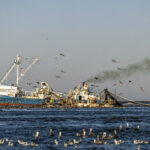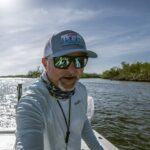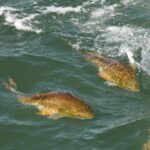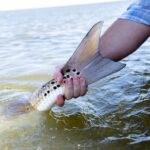
Gulf Menhaden Reduction Fishery: Bycatch Research & Useless Buffer Zones
Do you remember your driver’s test? How nervous were you when the instructor pulled out
If Commissioners don’t do the right thing next week, we risk immense localized depletion
Originally Published Here on Fissues
By Tony Friedrich
Several of weeks ago, the Atlantic States Marine Fisheries Commission, received a letter from John Bull, Virginia ASMFC commissioner stating,
“Virginia hereby appeals the decision of the Atlantic Menhaden Management Board (the “Board”) to set the coast-wide total allowable catch (“TAC”) for menhaden at 216,000 metric tons for the 2018 and 201 9 fishing seasons and to adopt certain portions of Amendment 3 to the Atlantic Menhaden Fishery Management Plan (“FMP”). Specifically, Virginia challenges the decision to allocate the TAC in a way that results in an unanticipated and unfair reduction in Virginia’s allowable menhaden landings and the decision to lower the Chesapeake Bay Reduction Fishery Cap (the “Bay Cap”) despite the lack of supporting scientific information. Taken together, these decisions, which are unnecessary for the conservation of the fishery, impose severe and unfair adverse economic impacts on Virginia and prevent it from sharing in the benefits of the increased TAC.”
In summary, Virginia is contesting the menhaden decision on three levels.
First, Virginia claimed the historical landings period was not adequately addressed. Meaning, the fixed minimum allocation ignores the historical landings in setting the minimum. Second, Virginia states that there were unforeseen circumstances and impacts because ASMFC included new jurisdictions with a minimum of .5% of the overall quota. Finally, Virginia believes that there was an incorrect application of technical information. This area focuses on the Bay Cap.
The Bay Cap is the amount of menhaden that can be harvested within the Chesapeake Bay. Omega has been averaging about 51,000mt per year within the confines of the Chesapeake. We can’t be sure though. There’s a little-known regulation called “The Rule of Three’s”. That means that there must be three entities pursing the species for them to report at a certain level. If there aren’t three entities, reporting is less stringent.
On January 17, ASMFC responded to Virginia’s appeal. They disagreed with the first two positions.
First, ASMFC feels that the allocation is already heavily in favor of Virginia. They are the only state left on the East Coast that allows a reduction fishery for menhaden. Virginia already gets 80% of the quota. ASMFC feels, and rightly so, that other states would have far better footing to say allocation isn’t fair.
The second position of historical landings was also rejected. Virginia was looking for more quota. ASMFC proved that 94% of the decision making came from landings based on 2009-2011. The total allowable catch aren’t required to be based solely on historical landings information.
The third position regardin the bay cap was a different story.
For people living outside of the area, perspective is needed. The final numbers aren’t in for 2017. Virginia is projected to land 372,443,990 lbs of menhaden. Let that sink in for a moment. If you are a menhaden, you must swim through Virginia if you want to go to the Maryland portion of the Chesapeake. So, what do you think that does on a local level? Is it possible that removing almost 400 million pounds of a keystone species per year could be bad for predators?
For years, we have tried to prove that the reduction fishery creates localized depletion of menhaden in Maryland. You would think this would be a slam dunk argument. Apparently, it isn’t. The Bay Cap was set at 51,000 mt because that was the best guess of the average amount of menhaden removed by Virginia. So, the cap wasn’t a reduction at all. It just set a limit based on an average yearly catch.
Science could not prove that removing almost 400,000,000 pounds of bait hurts the estuary. So, it looks like the Bay Cap will return to 87,000 mt.
It is hard to quantify what will happen if the bay fishery is expanded to this level. What I can say is that in 2010, prior to the original harvest reductions, osprey had the lowest chick recruitment since DDT was outlawed. Seventy percent of resident striped bass had mycobacteriosis, a chronic wasting disease that is 100% fatal in aquaculture. Weakfish don’t get bigger than 11 inches due to natural mortality. That’s science speak for saying, “There aren’t enough menhaden and the spike weakies are like snicker bars for big stripers and bluefish.”
As you may know, Omega Protein was recently purchased by Cooke, a Canadian aquaculture corporation. Cooke has a lot of salmon to feed. They have operations in Canada, the U.S., Scotland, Chile, and Spain (sea bream). You may have heard of Cooke recently. They are the company that had salmon escape into the pacific northwest. This escape could be catastrophic for already imperiled native salmon species in the area. These are also the salmon that aren’t nearly as good for you as the wild ones.
If Cooke wants to minimize costs, they will try to burn less fuel and catch as many menhaden as possible as close as possible to Reedville, VA, the harbor for the reduction fleet. Raising the Bay Cap would accomplish this goal.
To further exacerbate the situation, the menhaden fishery in Virginia is managed through the legislature and not Virginia Marine Resources Commission. (Are you starting to see a trend here?) So, there will be no public comment period for this appeal. The legislature only has a short window to set the season for menhaden.
In conclusion, we worked tirelessly to manage menhaden based on their ecological value. We suffered a major loss in November when ASMFC decided to kick the can down the road once again and manage menhaden as a single species meant for harvest. The only victory was holding the Bay Cap at 51,000 mt. Looks like we could lose that as well.
If you’d like to help, please email your ASMFC rep and ask them to keep the Bay Cap in place. It sure would mean a lot to us who live in Maryland. It might help us to grow more and bigger striped bass that I know you love to catch.

Do you remember your driver’s test? How nervous were you when the instructor pulled out

If you’ve spent any time on the water in South Florida, chances are you’ve heard

Photo Credit: Graham Tayloe Big Win for Redfish in Alabama Huge news from the Marine

Feature Photo: Carter Abramson | Simms Fishing at the Fisheries Science Symposium We have more
We rely on our members and donations to keep fighting for a sustainable tomorrow in marine conservation.
GIVE THE GIFT OF FISHERIES CONSERVATION THIS HOLIDAY SEASON. SHOP ASGA GOODS THAT FUND FISHERIES RESEARCH & ADVOCACY CAMPAIGNS
JOIN ASGA IN CALLING FOR CRITICAL MANAGEMENT ACTION AFTER YEARS OF SPAWN FAILURES & POOR MANAGEMENT.
By using this website, you agree to our use of cookies. We use cookies to provide you with a great experience and to help our website run effectively. To learn more, please review our privacy policy.